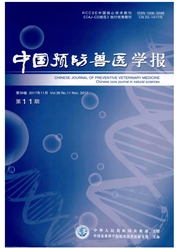

 中文摘要:
中文摘要:
2006年5月以来,我国部分猪场暴发了一种以高热、高发病率和高死亡率为特征的传染性疾病,经病原分离及分子流行病学分析证明是由一种带有nsp2部分缺失的、对猪呈高致病性的猪繁殖与呼吸综合征病毒(Porcine reproductive and respiratory syndrome virus,PRRsv)引起的。本实验参考GenBank发表的以及本实验室分离鉴定的PRRSV的nsp2基因序列,在nsp2缺失区的两端的保守区设计并合成了一对引物,建立了一种PRRSV的RT-PCR检测方法。该方法扩增高致病性PRRSV基因组时可获得230bp的片段,扩增经典型PRRSV时则获得320bp的片段,根据RT-PCR产物大小可将二者区分开来。通过大量临床病料的检测,并配合PCR产物测序验证,结果表明该方法简便、快速、特异,可以鉴别高致病性PRRSV,为进一步的PRRS流行病学研究提供了重要的技术手段。
 英文摘要:
英文摘要:
Since May of 2006, serious outbreaks of a highly contagious disease marked by high fever and high morbidity and mortality have occurred in China. Etiology studies confirmed that the disease was caused by a highly pathogenic porcine reproductive and respiratory syndrome virus (PRRSV) characterized by two non-continued deletions in the nsp2 region of viral genome. In the study, a RT-PCR was developed using a pair of primers designed according to the nsp2 gene sequence of PRRSVs deposited in GenBank and the highly pathogenic PRRSVs isolated in our laboratory. This method was shown to specifically amplify a 230 bp fragment from the highly pathogenic PRRSVs or a 320 bp fragment from the classical form of PRRSVs. Test on a large number of clinical samples showed that this method was highly specific and can be rapidly performed in a standard PCR setting. Therefore the RT-PCR could be used as an effective tool for differentiating diagnosis of the highly pathogenic PRRSV in epidemiological investigations.
 同期刊论文项目
同期刊论文项目
 同项目期刊论文
同项目期刊论文
 期刊信息
期刊信息
